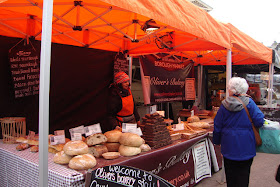The first day of the Ganesha festival was Monday, the 9th of September. Today, it’s six days already since the festival began. If one were to step out onto the street here at Bannerghatta road in Bangalore, there would be little to tell us that it is Ganesha time. Our Bilekahalli locality is not a prominent marketplace, like the Malleswaram market or like Gandhi Bazaar. But, on the day before the start of the festival, this small bazaar comprising of just a few pushcart vendors was a place of celebration and festivity! That was for me the bit to contemplate about Ganesha festival this year. To know how small neighbourhood bazaars have so much happening during a festival and are totally joyous for that day.
The next day evening, on Monday, the vendors were already dismantling their display systems, the metal tables that they had taken on hire for a day. The little Ganeshas that had been sitting on these tables all of Sunday and Monday were all gone. The banana leaves were not to be seen. There was garbage everywhere and it had been raining a little. Of course, it was all a mess and you couldn’t see any celebration any more. But, so what, Sunday had been a special day here!
On the morning of Sunday, we had gone all the way to the Malleswaram flower market. It is quite far from our B.G.Road. We had been invited by cousins to a morning walk in Malleswaram which was to be followed by the traditional breakfast routine. The bazaar bit was exciting but the breakfast bit more exciting. I’ll come back to that later.

We were now at the flower market. Of course, it was beautiful. And, it was busy. It was in fact very busy that morning. The stretch outside the market entrance had a long row of vendors selling banana leaves. They stood almost just off the footpath. No, they stood on the footpath, but the banana leaves stood on the road. I mean, there would be no place to walk otherwise. And, right there, was the Bus stop and people waiting for the bus. Nobody complained. Each one did what he or she had to do. Vendors looking after their banana leaves and lotus flowers, customers bargaining in voices that you couldn’t hear in that crowd and noise and commuters with their eyes on the road for the next bus.
And walking further down the road on 8th Cross was the real bazaar of the day, the Ganesha bazaar, where you could choose from the usual painted 'plaster of paris' Ganeshas or you could bring home the eco-friendly Ganesha. A report in
DNA last year had written about this gradual change to eco-ganeshas:
Ganeshotsav 2012: Clay all set to plaster Paris out and today an article in
The Times of India writes about:
Use of eco-friendly Ganeshas on the rise.
Both of these newspaper articles are about the Ganesha in Bombay. For those in Bangalore, there’s more about the eco-ganeshas at
Eco-Ganesha: Where to find him, and why?, a
Citizen Matters article that talks about what is eco-ganesha, the do’s and don’ts for this Chaturthi and about ‘BBMP’s rules for the festive season’ which is quite good to read also because it makes you realise how much work and responsibility a festival can generate for a local municipality. It's more work for them with every festival we celebrate. Also, with the
Kadlekai Parishe or Groundnut festival that happens at Bull temple road every year. I've written about that earlier at:
Policing the Urban space.
Coming back to the streets of Malleswaram, there were also sweet vendors along the footpaths. Just as we had bought some and were already into eating the coconut barfi right there, it started to rain. We wished it hadn’t rained that morning. The vendors had to quickly cover their wares with large blue plastic sheets that they had ready with them. All the people who until then had been strolling casually and stopping at every few feet had to take shelter under some of the shop awnings. It wasn’t heavy rain, it was a drizzle, but everyone had to think of rushing their shopping and getting back home sooner.
This wasn’t the end of our trip to Malleswaram. The rain had stopped after a while and we were on our way to Veena stores, for what were considered the best idlis this side of town. Our side of town (not Bannerghatta road, but further away at Basavanagudi) you could get good idlis at Brahmin café or at Vidyarthi Bhavan in
Gandhi Bazaar. That was our favourite traditional place closest to home. Nothing else on the way, and, nothing on B.G.road could even be considered as a breakfast place to go to. But, yes, the Veena stores idlis were really good. We had been asked earlier by our cousins if idlis were what we wanted. Because, if we preferred dosas, then, they would have taken us to another part of Malleswaram!
I’m not done yet. There’s just a bit more. We happened to step into Naturals Icecream in the Adigas Lane on Bannerghatta road that same afternoon. We had to pick up some icecream for a lunch get-together. So, we go in and there’s some excitement in the air, with some people trying out the flavour of the day. And, what was that? The
prasadam icecream. So, we tasted it and were told that it was the ‘modak’ flavour. Earlier, we had eaten the ‘panchamrutam’ icecream at Saravana Bhavan at the
Mylapore Bazaar in Chennai. We always remember that one fondly. Here, the modak flavour had a distinct coconut and jaggery taste to it. Absolutely wonderful! For those of you who haven’t tasted it yet, it’s available until the tenth day of the Ganesha festival!
I’ve uploaded a few other photos on the Indian Bazaars facebook page at:
Ganesha festival bazaar at Malleswaram. Please do check it out!





















































